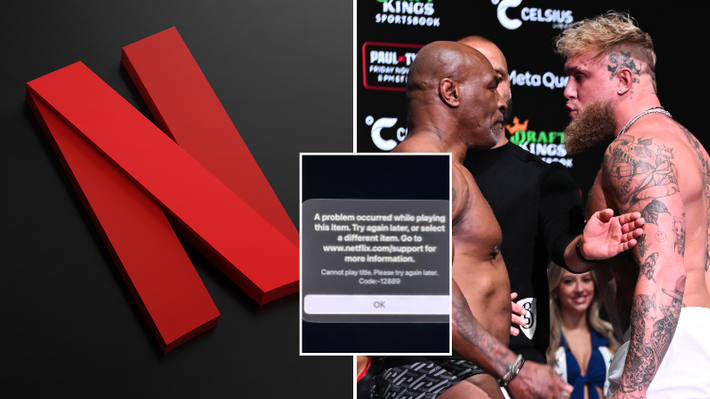When Live Streaming Breaks: A Technical Breakdown of Netflix’s Crash During the Tyson vs. Paul Fight
 Aditya Lad
Aditya Lad
The highly anticipated Tyson vs. Paul fight on Netflix brought millions of viewers together for an electrifying night of entertainment. But what should have been a seamless live-streaming experience quickly turned into a technical nightmare. Let’s dive into the reasons behind this failure, explore Netflix’s typical architecture, and discuss the lessons the streaming giant and other services can learn from this event.
Netflix's Normal Content Delivery Model: Reliable But Limited for Live Events
Netflix is known for its exceptional ability to handle millions of concurrent viewers. This capability comes from a sophisticated system called Open Connect Appliances (OCAs). Here’s a brief overview of their typical setup:
OCAs: Local Content Delivery
These specialized servers are distributed globally, serving popular shows and movies directly to nearby users. By decentralizing content delivery, Netflix ensures fast, high-quality streaming with minimal buffering.Regular Streaming Architecture
Edge Locations: Thousands of servers worldwide reduce latency.
Load Balancing: Distributes traffic efficiently to avoid server overload.
Caching System: Frequently accessed content is stored closer to users.
Adaptive Streaming: Adjusts video quality based on network conditions.
In essence, the architecture is finely tuned to handle on-demand content. However, the Tyson vs. Paul fight was no ordinary event, and the unique challenges of live streaming stretched Netflix's infrastructure to its breaking point.
The Complexity of Live Streaming: What Went Wrong?
Unlike pre-recorded content, live streaming comes with its own set of demands:
Real-Time Encoding
In live streaming, content is captured and processed in real-time. This means encoding must happen instantly to ensure that viewers experience minimal latency. For the fight:The sudden surge in viewers overwhelmed Netflix’s real-time encoding system.
Encoding could not keep up with the volume, creating a backlog and causing streaming delays.
Concurrent Connection Overload
On a regular night, viewers start shows at staggered times, but with the live fight:Millions tried to connect simultaneously, all demanding the highest quality stream possible.
The surge in concurrent connections led to server strain, causing interruptions and buffering.
Cache Miss Problem
OCAs usually store pre-recorded content for quick delivery. During the live event:There was no pre-cached content to serve.
Every request had to hit Netflix’s main servers, leading to increased latency and failures.
Database Strain
Authentication and session management systems faced extreme loads:Many users struggled with logging in or maintaining their streaming session.
The unexpected demand led to database saturation, further exacerbating service interruptions.
The Infrastructure Impact: Systemic Failures Across the Board
The crash highlighted weaknesses at multiple levels of Netflix’s infrastructure:
Network Layer
The Content Delivery Network (CDN) was overwhelmed by concurrent requests. Limited bandwidth capacity and TCP connection exhaustion were major contributors.Application Layer
APIs hit their rate limits, microservices began to fail, and circuit breakers triggered, resulting in a domino effect across various services.Database Layer
Connection pools were maxed out, read/write conflicts surged, and backup systems proved ineffective against the deluge of requests.
How Netflix Can Improve: Technical Solutions
The fight’s debacle offers several key takeaways:
Better Capacity Planning
Netflix can predict demand using a combination of historical data, social media activity, and pre-registrations.Enhanced Architecture
Auto-Scaling Capabilities: Deploy dedicated live streaming infrastructure capable of instant scaling.
Separate Authentication Paths: Live events should have their own dedicated authentication mechanisms.
Load Shedding: Use more aggressive load-shedding techniques to prevent total system crashes.
Improved Stream Management
Multiple Ingestion Points: Distribute streaming load across geographically distributed servers.
Redundant Encoding Pipelines: Implement backup encoding mechanisms to avoid bottlenecks.
Quality Adaptation Logic: Optimize real-time adjustments to video quality based on demand spikes.
Dedicated Live Streaming Backbone
The solution isn’t just about adding more servers. Netflix needs to adopt a hybrid infrastructure capable of handling traditional on-demand and live content simultaneously.
Key Takeaways for Future Live Events
Infrastructure Changes:
Dedicated live streaming backbone
Separate scaling policies
Enhanced monitoring systems
Robust failover mechanisms
Process Improvements:
Load testing based on realistic patterns
Gradual user ramp-up during live events
Clear incident response protocols
Effective communication during outages
Final Thoughts: Rethinking Live Streaming for Netflix
The Tyson vs. Paul event exposed cracks in Netflix’s well-oiled machine, but it also presents an opportunity for growth. By developing a robust hybrid infrastructure that can handle both traditional streaming and live events, Netflix can offer unmatched experiences for every viewer. The path forward requires innovative thinking, meticulous planning, and a willingness to rethink their existing model from the ground up. Live streaming is the future, and Netflix must evolve to stay at the forefront.
Subscribe to my newsletter
Read articles from Aditya Lad directly inside your inbox. Subscribe to the newsletter, and don't miss out.
Written by
